Europe, British Isles, England, Welsh March, Cheshire, Wybunbury, St Chad's Church [Map]
St Chad's Church, Wybunbury is in Wybunbury.
In 1833 the body of St Chad's Church, Wybunbury [Map] was demolished and a new church was built. The architect, James Trubshaw (1777-1853), straightened the tower by removing soil from the higher side and soaking the ground so that the tower settled back straight. This technique used by James formed the basis of the method used in the 1990s to stabilise the Leaning Tower of Pisa. James rebuilt the body of the church in a style loosely based on the previous building.
This was replaced in 1892-93 by a church designed by James Brooks FRIBA (1825-1901).
After 21 Dec 1614. St Mary's Church, Nantwich [Map]. Monument to Thomas Smith of Hough in Cheshire commissioned by his wife Anne Brereton. The monument, carved by Hugh Hall, was originally in St Chad's Church, Wybunbury [Map] but moved to Nantwich in 1982. Jacobean Period.
Thomas Smith of Hough in Cheshire: Around 1545 he was born to Lawrence Smith and Anne Fouleshurst. On 21 Jan 1561 he and Anne Brereton were married. On 21 Jun 1614 he died.
Anne Brereton: In Dec 1546 she was born to William Brereton and Jane Warburton. After 1614 Anne Brereton died.
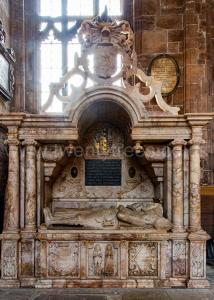
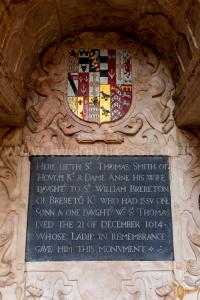
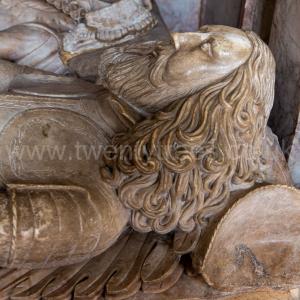
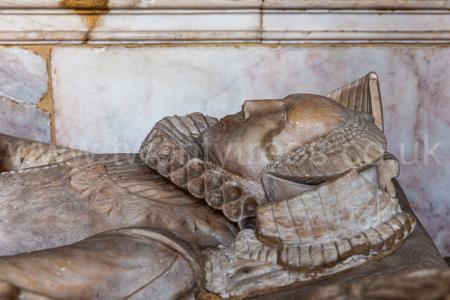
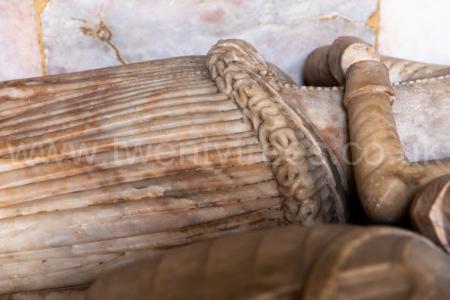
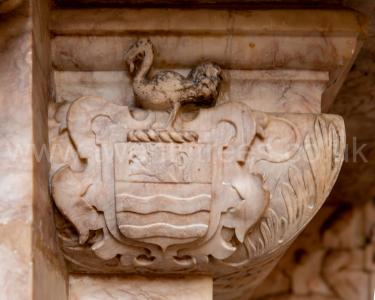
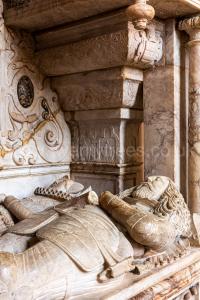
On or before 25 Dec 1736 John Sparrow of Bishton Hall in Staffordshire was born to Ambrose Sparrow (age 67). He was baptised 25 Dec 1736 at St Chad's Church, Wybunbury [Map].
Chester Chronicle, and Cheshire and North Wales General Advertiser. 30 Apr 1892. The Duchess Of Westminster (age 35) At Wybunbury.
Laying The Foundation Stone Of A New Church.
A new epoch in the church history at Wybunbury [St Chad's Church, Wybunbury [Map]] was celebrated on Monday afternoon, when the Duchess of Westminster (age 35), in the presence of a large gathering of churchpeople, formally laid the foundation stone of a new church.
The ceremony was one which the Duke of Westminster had promised to perform, but owing to unavoidable circumstances, His Grace was unable to attend.
A procession of church choirs, consisting of Nantwich, Wisaston, Audlem, and Wybunbury (surpliced for the first time) was formed at the Wybunbury Girls' School, and, headed by the bishop (age 47), the Rev. C.A. Stolterforth (Vicar), the Rev. F.G. Blackburne (Nantwich), the Rev. W.C. Reid, and the ministers of neighbouring parishes, marched, singing an appropriate processional hymn, to the site whereon the new church is to be erected.
The service here was in keeping with hearty church worship. The words of the hymns and psalms had special significance to the occasion, and the voices all sang with one accord the praises of the hour.
Upon the raised platforms were gathered some of the best county families. The Duchess of Westminster was supported by Lord Arthur Grosvenor (age 31), and there were also on the platform showing the same interest in the founding of the new church which his ancestors, who lie in the tombs of old Wybunbury churches, are reputed to have evinced in church work in the parish, Mr Louis Delves Broughton (age 34) and Mrs Broughton (age 27). Mr Twemlow, of Betley Court, was also an interested spectator, as was Judge Hughes who came over from Chester and mingled amongst the crowd.

The Duchess very gracefully performed the foundation stone laying, after which Lord Arthur Grosvenor apologised for the absence of His Grace, who said that he had been laid up with a cold for two or three days. In conclusion he wished every success to the building of the new church.
The Bishop (age 47), in the course of some remarks, said that they were refounding the old Church of St Chad's upon St Mark's Day, and St Mark's Day was peculiarly appropriate for such a work because the very keynote of St Mark's Day, as the character and life of the apostle was set before them in Holy Scripture, and in the service of their prayer book, was stability and recovered stability. He was sure that everyone here hoped that the work started today would be carried on with all that thoroughness or workmanship could bestow upon it, and that future generations would look back to the work begun today as worthy of both man and God. In conclusion the bishop gave hearty expression to the thanks of the congregation to the Duchess of Westmnister, to Sir Henry Bristowe and Miss Bristowe to whose energy and zeal he alluded, as also to the active work of the late Mr Acton, who was one of the churchwardens, and to whose memory he paid a tribute of respect, and to those who by their presence and support had assisted in the progress of the movement.
After the ceremony, tea was provided in a tent, and an organ recital was given in the evening.
The site of the new church is the site upon which the old church was built, and upon which, in fact, at least four Wybunbury churches have stood. The church at Wybunbury has a grand history. The records of the parish, although incomplete, prove that so far back as 1290 Wybunbury had its church and also its vicar. The identification of the latter is somewhat scanty, but the church records clearly set forth that Roberts was the name of the vicar at this early period. But there are forthcoming fragments of early church architecture which the workmen in digging up the foundations have come upon, that prove there was a church esxisting here even before 1290. They unearthed in a well-preserved state a stone so distinctly shaped and chiselled that the architect, Mr Spooner (Charles Sydney Spooner, 1862-1938 - Stu), who has had 20 years of experience of architecture, was persuaded that it belonged to the Norman style of architecture, or First Pointed or Transitional period. The stone was discovered in the rubble of the church, and had probably lain there for hundreds of years. The date is from 1130 to 1150, and it suggested that at some time it formed part of a circular doorway. Other stones have been discovered, several of which are of the 15th Century style of architecture, and it is supopsed that these once formed part of an arch. The fabric of the church of 1838, which in architectural phraseology was of the Churchwarden Gothic Style, has been demolished, with the exception of a good part of the south wall. The foundations of the demolished were very building were unsound, and the beams which supported this structure has shifted several inches. The builder of 50 years ago succeeded in restoring to the tower the perpendicular, a gigantic work, as in that day the tower had got out of position to the extent of 5 feet 6 inches.
The new church will be built central with the tower, and will be as near as possible a facsimile of the fifteenth-century church. There will be no galleries which formed part of the old church. The organ and vestry will be built in the south chancel aisle, and in the north chancel aisle there will be a Morning Chapel.
The foundation will consist of monolithic slabs of Portland Cement. The concrete for the foundation will be a thickness of 3 feet six inches, and the whole will be bound together by a network of inter-ties. The stones which have been unearthed will again be utilised for building up the new church, and a number of brass plates, which bear the names of long since dead parishioners who lie within the tombs of the church, will be carefully put back again. One of these plates is of great antiquity and is one of half a dozen similar plates in the county.
The cost of the new church will be about £6,000. Towards this amount a considerable sum has already been raised. The Duke of Westminster sent a donation of £100, and a collection on the ground realised a considerable sum. The work will be completed in about 12 months.
The architect is Mr James Brookes, the well-known church architect, of Wellington Street, Strand, London, and the clerk of the works is Mr Spooner. Messrs Treasure & Son, of Shrewsbury, are the contractors; and Mr John Bebbington is foreman of the works.
Chester Chronicle, and Cheshire and North Wales General Advertiser. 05 Aug 1893. Church Consecration By Bishop Jayne.
The consecration of Wynbunbury Church [Map] was performed by the Lord Bishop of Chester (Dr Jayne) (age 48) on Thursday. This interesting event proved a red-latter day in the church life of the district, this being evidenced by the general display of bunting, flags etc.
The vicar (the Rev. C.H. Stolterforth), and the churchwardens Messrs E.R. Bellyse and Charles Edwads, together with the building committee, have worked hard to bring about the present state of affairs, and assisted by the liberal response of all those connected with the church, and the assistance of the neighbouring parishes, the work will ere long be completed, and Wybunbury Chruch will then form one of the most beautiful in this part of Cheshire.
The consecration took place in the morning when there was a large congregation present.
In the course of his sermon the bishop said that their service was not unmixed with sorrow, and feelingly referred to the death of Sir Henry Fox Bristowe, and Mr Samuel Acton, who had taken a very active part in the erection of the church, and who had very liberally contributed towards it. He also touched upon the death of Miss Turner (daughter of the late vicar), who had lived in the parish a good many years, and had taken much interest in the building of the church.
At the close of the consecration service a public luncheon was provided in the Delves Schoolroom, at which there was a large attendance. In the afternoon there was an organ recital by the Rev. C.H.H. Stewart, Vicar of New Brighton, and the late precentor of Chester Cathedral.
At 5.30 a public tea was given in the Delves School. In the evening, the Very Rev. S.R. Hole DD (age 73), Dean of Rochester, preached to a crowded congregation.
The offertories in the morning amounted to £38 13s 9 1/2 d'.